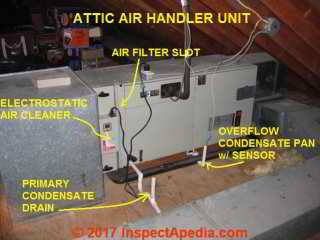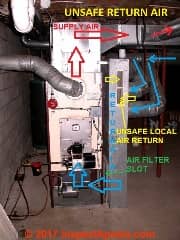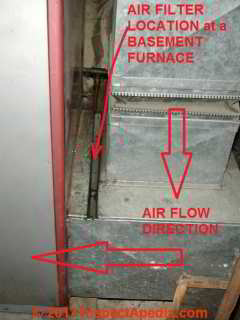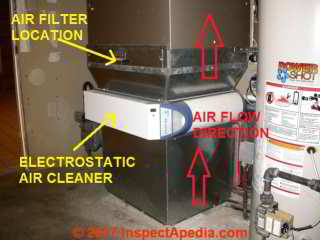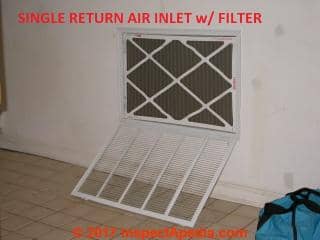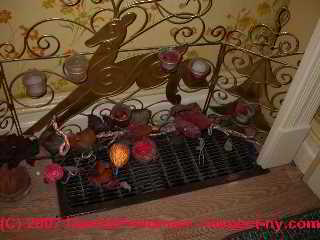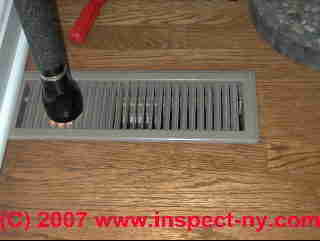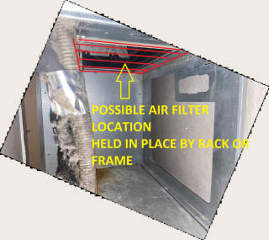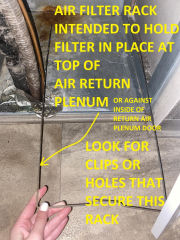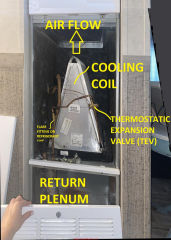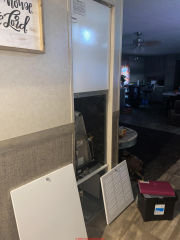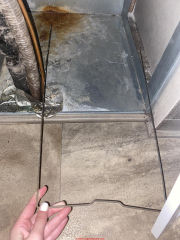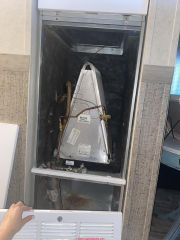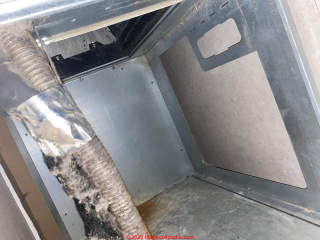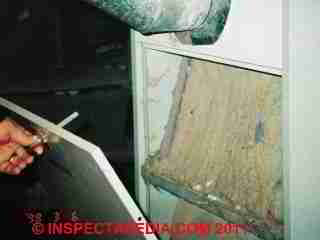 HVAC Air Filter Location & Renewal
HVAC Air Filter Location & Renewal
How to Find & Change the Air filter on an Air Conditioner or Furnace
- POST a QUESTION or COMMENT about the location of air filters on air conditioning & heating systems
Where air filters are installed on air conditioning or heating systems:
This article explains in detail how to find the air filters on an air conditioning or hot air heating system.
Knowing where air filters are typically located can help find dirty or clogged air filters that are increasing air conditioning or heating cost. Before assuming that your HVAC system does not have an air filter installed, or that it has only one air filter installed, check the locations we describe here.
InspectAPedia tolerates no conflicts of interest. We have no relationship with advertisers, products, or services discussed at this website.
AIR FILTER LOCATION - How to Find the Air Conditioning Filter on Air Conditioners or Hot Air Heating Systems
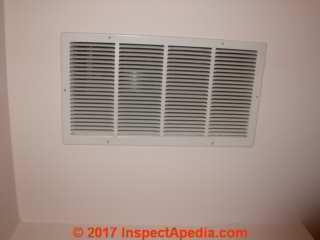 If you can't find your air conditioner system filters (there may be more than one air filter) here are some places to look.
If you can't find your air conditioner system filters (there may be more than one air filter) here are some places to look.
After reviewing this list of air filter locations, if you still cannot find your heating or air conditioning system air filter read our detailed instructions on how to find air filters which follows just after this list.
Photo: a ceiling return air inlet for an air conditioning system in a U.S. home. In a two-story home the contractor often locates this return centrally near the top of a stairwell.
- At the central air return register, grille located in a ceiling or wall if your system uses centralized air returns instead of individual room-air return ducts.
There may be several central return points, depending on the design of your system. If there are more than two, chances are the filter was placed at the air handler instead of at these grilles.
Unfortunately that means that the return ducts themselves become more soiled with dust and debris from the building. - At an attic air handler look for a slot which has a removable cover. The slot may be just an inch or so wide if 1" thick filters are used, or it could be several inches wide if a wide high-capacity pleated or similar filter was used.
The return air plenum on an attic or basement air conditioner blower unit will usually be a large metal enclosure about the same dimensions in width and height as the air conditioner blower unit itself.
Look for a filter slot right where the return plenum contacts the blower fan assembly - marked as AIR FILTER SLOT and yellow arrow in my photo. If you click-on and enlarge the image you may see a black bolt or screw at the top of the air filter slot cover - remove this to lift the filter slot cover up and out.
The air filter itself will slide directly out - or rather it would if some dope hadn't taped the electrostatic air cleaner power cord to the condensate drain so tightly that it will block air filter removal. The homeowner changing the filter will need to un-tape and loosen the blocking cord.
[Click to enlarge any image]
- At a basement air handler we also look for a filter at the return air plenum which is often next to the bottom of the air handler if the system is an "up-flow" unit (or vice versa for the less common case of return air entering at the top of the air handler and exiting at its bottom).
Above: this basement oil-fired heating furnace is an up-flow unit: return air from the building (blue arrows) moves from the building's occupied space through return ducts (blue arrows) into the bottom of the heater.
Heated air moves out of the unit into supply ducts (red arrows) and back into the building.
[Click to enlarge any image] to see more detail.
Watch out: We marked in yellow an unsafe return air inlet grille placed right in the basement on the reutrn air plenum itself.
Someone probably added this air inlet (yellow arrows) to improve the total air flow through the system, but drawing return air from close to the oil or gas burner on a furnace can
- cause improper burner operation (interfering with combustion air supply)
- draw oil fumes or gas odors into the building supply air
- can kill building occupants if these conditions cause carbon monoxide production and spillage at a gas burner
Also see UNSAFE DUCT OPENINGS for more about this hazard.
Below: a closer-look at an air filter slot at a typical upright air handler on a basement heating or heating+air conditioning system.
Below: this photo shows a very common air filter location: behind a service door on the back of an upright warm air furnace or furnace/air conditioner combination unit.
- Next to an electrostatic air cleaner: if your air conditioning air handler has an electrostatic air cleaner installed, look for the filter, if there is one, next to the electrostatic air cleaner. In addition, the electrostatic air cleaner, which is a type of particle incinerating filter itself, needs to be removed and cleaned periodically.
In our photo below, the silver handle above the white electrostatic air cleaner is a tip-off that a removable filter is installed there.
Check with your unit's manufacturer for cleaning interval and procedures.
Often the electrostatic unit can be cleaned inside a dishwasher. Often there is also a thin metal washable air filter installed along with the electrostatic air cleaner.
If after reading this catalog of air filter locations you still can't find your air filter, below we
provide AIR FILTER LOCATION-MORE examples of where and how to look for filters on an air conditioning or hot air heating system.
A Detailed Guide on How to Find the Air Filters on an Air Conditioning or Heating System
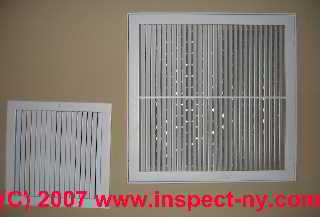 Central air conditioning filters (or heating system filters if hot air heat is used as well) are sometimes hard to find.
Here are some tips on where to look to find the filters on your central air conditioning system:
Central air conditioning filters (or heating system filters if hot air heat is used as well) are sometimes hard to find.
Here are some tips on where to look to find the filters on your central air conditioning system:
How to Find Air Conditioning Filters Located in the Air Duct System
Central Air Return Registers and Filters on Air Conditioning or Heating Systems
Central air returns - Air conditioning filters located on central air return registers:
if the system uses one or just a few central return registers very often a filter is placed behind the inlet grille at the central air return and is
easily spotted in installations such as this Arizona central air conditioning air return inlet in the ceiling of a new home - the large rectangle is
a return inlet where the air filter is quite visible.
In this photo the small opening is a poorly-installed supply register - air coming out of this register will simply be drawn right back into the return air inlet and won't do much good for the rest of the building.
Look for central air returns on building ceilings and WALLS [photo] in central areas such as in the ceiling near the top of a stairwell to an upper floor, or on lower floors look on hallway ceilings. Below is a central air return on the wall of a New York home.
This wall return air inlet sports a pleated air filter right behind the hinged grille opening. To minimize the airborne dust levels in this home we used
a CASCADED AIR FILTER DESIGNS for which the wall filter shown here was the easily-accessed first-stage of dust filtration.
Don't forget to look for central air return registers on floors too, such as shown in this photo of a return air inlet in the front hallway of an older New York home.
We noted that a bit of reduction in air flow and a bit of increase in home heating cost may be the result of leaving stuff on top of the return air inlet.
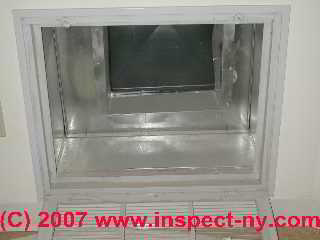 Sometimes there will be a central air return in a ceiling but without any filter as shown in our photo at above/left and in this additional example of
Sometimes there will be a central air return in a ceiling but without any filter as shown in our photo at above/left and in this additional example of
a WALL MOUNTED RETURN AIR INLET [photo] .
In that case we'd expect to find an air filter at the air handler unit.
It is usually been better to put the filter at the wall or ceiling return register grille since that way the return air ducts are protected from debris accumulation.
Central return registers are normally located in one or two common areas of the building where they will not be accidentally "shut off" by someone closing a door.
For example, a bedroom won't normally have a central return register since closing the bedroom door would shut off other building areas from the return air path.
This photo shows what you'll see when you open a ceiling return air register and remove the filter that (should have been) installed there. The duct surfaces in this ceiling look rather clean - the filter has been doing its job.
You may see house dust deposits around the edges of the opening into which the air filter is mounted - showing where air bypass leaks are occurring.
Some air filters include a gasket to seal these locations against air and dust leakage. Sometimes these leaky openings at air filters also cause noises when the air handler is running.
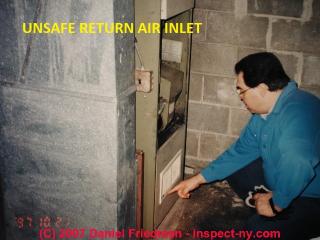
Watch out: If a building air conditioning or heating system air handler gets its return air right at the air handlersuch as in this
PHOTO of a BASEMENT AIR HANDLER
the system has several operating problems: it is unsafe if it can draw combustion gases or mold into the duct system, the system lacks adequate return air and so will not deliver good air flow into the living area.
And the system will have high operating costs because the air flow is "one-way" drawing constantly "new" air from the basement into the air handler to be warmed or cooled and sent "one way" into the living area. Return ducts should bring air from the living are back to the air handler for cooling or warming.
See BACKDRAFTING HEATING EQUIPMENT and
also COMBUSTION AIR for TIGHT BUILDINGS for additional details.
Individual Room Air Returns and Filters on Air Conditioning or Heating Systems
Individual room air returns - look in each room where there is an air conditioning supply register to see if the room also contains a return air registers.
Since some rooms have multiple air supply registers and ducts we need to know how to distinguish a supply air register from a return air register.
How to identify individual room supply air registers
The supply registers are usually located in a CEILING [photo] or in a building WALL [photo] but may be in a floor too (as shown here), usually near an exterior wall.
Air conditioning supply registers usually have an ADJUSTABLE LOUVER [photo] at a ceiling or wall supply register.
The louver (notice the little lever at the right end of the register cover?) that permits the air supply register to be opened or closed.
Which way is the air blowing, in or out of a heating or cooling register?
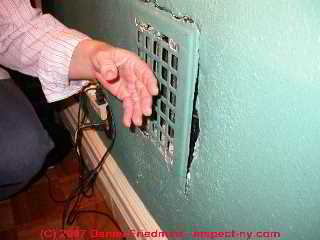 If the heating or cooling system is operating, you can expect to feel air blowing OUT of a SUPPLY REGISTER [photo] and
you may feel air moving into a return register.
If the heating or cooling system is operating, you can expect to feel air blowing OUT of a SUPPLY REGISTER [photo] and
you may feel air moving into a return register.
But don't be confused. Air moving into a return register also may just be felt as an airflow across your hand and you may not be sure which way the air is moving.
Holding a simple piece of tissue paper next to an air register will by its movement show you for sure which way the air is moving.
How to identify individual room Return Air registers
Once you've located the air conditioning or heating air supply registers, look in the same room to see if there are other registers that collect return air to take it back to the air conditioning air handler.
Return air inlet registers are usually louvered as well, but will normally not have adjustable openings that can be opened or closed.
Main air filters are rarely installed on individual room return (or supply) air registers, but identifying the presence and the location of both supply and return air registers will help us understand whether or not the system uses central returns or individual room air returns, or a mix of both.
That in turn will tell us whether or not to look for filters at central return registers.
Individual air register filters: Sometimes you may see some filter like material installed right on individual air supply or air return registers in rooms.
These are usually "add-on" products that occupants have installed, perhaps in complaint that the duct system itself is dirty and that central filters have proven ineffective, or people may install individual register filters out of a general anxiety about building indoor air quality.
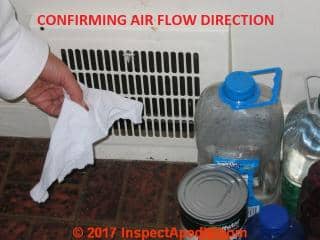 OPINION: individual air supply or return register air filters are either ineffective (not trapping much debris), or if they are effective, they are at risk of significantly reducing the air flow into the rooms where they are used, reducing the effectiveness of the cooling or heating system or increasing system operating costs.
OPINION: individual air supply or return register air filters are either ineffective (not trapping much debris), or if they are effective, they are at risk of significantly reducing the air flow into the rooms where they are used, reducing the effectiveness of the cooling or heating system or increasing system operating costs.
If the building duct system is so dirty that people are installing these filters it may be preferable to have the duct system professionally cleaned.
If a building uses both supply and return air registers in every room, that is, if it is not using central air return registers at just a few locations, then the air filters for the system are most likely going to be found on or very close to the individual air handlers or blower units themselves.
Photo: I'm holding a bit of tissue paper in front of an air register while the furnace (or air conditioner) is operating.
Even a weak air flow at a register will move the tissue showing the direction of air flow. This is a supply register: the tissue is blown away from the register's opening.
We would have guessed that this is a heat or cool air supply register by the presence of louvers inside of the register grille and by the control lever that can open or close them.
Operable control louvers to adjust air flow are normally found only on supply air outlets into the occupied space, while return air registers or grilles normally have no lever controls.
How to Find Air Filters Located At or Near Air Conditioning or Heating Air Handlers or Air Blower Units
When air filters are not found at return registers in a building the most likely place for an air filter to be found is at or even inside the air handler itself.
Some buildings use multiple air handlers, providing air conditioning and/or heating to individual floors or to different building areas on the same floor, so be sure you locate all of the air handlers or blower units in the building.
How to find Air filters located at the return air plenum next to the air handler unit
At the blower unit observe that large ducts will be connected to bring return air from building return ducts into the blower unit and to send conditioned air (cooled or warmed) out of the blower unit into the building supply ducts.
Look first outside the blower unit where return air is entering the blower cabinet.
How to Identify Horizontal, Vertical, Up-Flow or Down-Flow Air Handlers or Blower Units
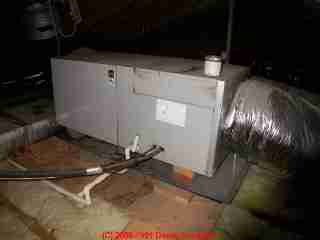
Air handlers are installed either horizontally (in an attic or crawl space) or vertically (in a basement, high attic, or other building area). Photos of horizontal and vertical air handlers are shown in this article and at our website.
Horizontal air handlers such as the attic mounted horizontal air handler in the photo above will have return air entering one end of the air handler unit and supply air exiting at the other end.
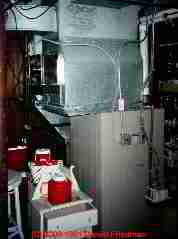
Vertical air handlers may be an "up-flow unit" which has return air entering at the bottom of the air handler or blower and conditioned air (cooled or warmed) exiting at the top of the unit.
The photograph shows a vertical or up-flow heating and air conditioner unit whose cooling section was mounted as an add-on atop a hot air furnace.
In this case the overhanging size of the top mounted cooling section suggests poor design - the sizes of the air moving sections are not matched.
Other vertical air handlers may be a "down-flow" unit which has return air entering the top of the air handler or blower and conditioned air passing out into supply ducts connected at the bottom of the unit.
Which side or end or top or bottom of the air handler blower has incoming return air and which has outgoing supply air?
Follow the duct work: If you were able to spot central or room air registers inside the living space, at the air handler unit you should be able to spot where those ducts enter the air handler itself. That will tell you which end of the air handler has entering return air.
Feel the outside temperature of duct work at the air handler: If you cannot determine where return air ducts are entering the air conditioning or heating air handler, if the system has been running in air conditioning mode the supply or outlet air end of the ducts connected to the air handler will be cool or even cold, and the return air end of the ducts connected to the air handler will be warmer to the touch.
If the system has been running in heating mode, the supply or outlet air ends of the ducts connected to the air handler will be warm to the touch and the inlet or return air ducts will be cooler.
How to find the Air Filter at but not inside of the Air Handler
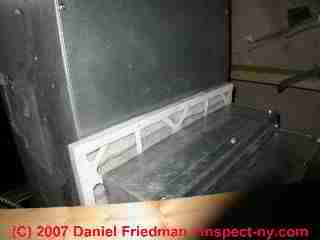
Air handler filters may be located between the return air plenum and the rest of the air handler which contains a cooling coil for air conditioning or a heat exchanger for heating systems, and also a blower fan that causes air to move across these components and out into the supply ducts.
This photo shows an air filter located between a return air plenum (at photo right side) and the bottom of the air handler unit.
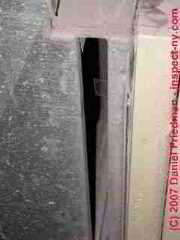
Locating the air filter slot at the air handler:: Now that you've identified the return air end of the air handler look closely in that area for a slot which is perhaps 1 1/2" wide and runs the entire width or height of the metal of the return air plenum (metalwork box connected to the inlet end of the air handler).
The slot may have a removable cover, but inside here should be located a central return air filter. Open the slot, remove the filter, and install a new filter.
If an ELECTROSTATIC AIR CLEANER [PHOTO] is installed at the air handler an air filter is usually installed in the air path just before or just after the electrostatic unit itself.
In this photo of a slot intended to receive an air conditioning filter at the blower unit, the filter had simply been left out and the slot left open - drawing dirt, debris, moisture, and mold from nearby basement areas. At the right side of the upper portion of the slot you can see our little piece of clear adhesive tape bending inwards, showing that air is flowing into the air handler at this filter slot.
How to find the Air Filter that is Located Inside of an Air Handler Blower Compartment
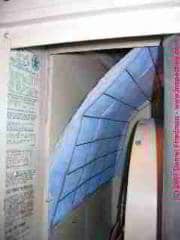
Many air conditioning system or warm air heating air handlers, both horizontal and vertical units, have one or more air filters that are installed inside of the blower assembly itself. These systems move air from a return plenum (connected to the return duct end of the system) across a cooling coil (for air conditioning) or a heat exchanger (for heating Systems).
On nearly all central air cooling or heating systems, the blower is located at the return air end of the system.
For many of these systems a filter or a set of air filters are located inside of the cabinet that contains the blower fan itself. Such systems can be recognized by a handle that is turned or pulled to open the blower cabinet.
This photo shows a blue fiber type filter located inside the blower compartment of the air handler.
The photo at the top of this page shows another conventional air filter located inside of a vertical air handler blower compartment - in that case the filter was very dirty and blocked with debris.
Watch out: SAFETY WARNING - injury risk: when opening a blower cabinet, older units may lack a safety interlock switch that turns off power to the blower fan. Reaching inside of a blower cabinet when the fan is running is very dangerous as you can lose fingers in the spinning air conditioner blower assembly fan or its drive motor or belt.
To be safe, turn off power to the unit before opening the blower compartment to inspect for and change a filter.
Opening the blower compartment door on these systems will expose one or several filters which are simply set in place on a frame. Normally the filters are placed inside of this box in a location which will filter air before it reaches the blower fan itself.
Watch out: SAFETY WARNING - filter direction: be sure to place the new air filter properly into its slot (at the air handler) or grille (for ceiling or wall mounted central air return filters). The edge of most air filters has an arrow showing the intended direction of airflow through the filter.
The filter is installed so that the arrow (and air flow) show air moving through the filter INTO the duct system (at a central air return grille) or INTO the air handler (for filters installed on the blower unit).
This is important because many filters are reinforced to prevent the airflow from collapsing the filter material and drawing it right into the blower fan itself. A collapsed filter that is drawn into a blower fan can cause fan overheating and even a building fire.
MAINTENANCE TIP: when inspecting the blower compartment interior of a central air conditioning or central heating air system look at the blower fan itself. Usually these are a round squirrel cage fan driven either directly by an electric motor or driven by a fan belt which is in turn connected to a pulley on a nearby electric motor.
Use a good light to examine the blades of the blower fan itself.
If the air conditioner or heating blower fan blades are clogged with dirt (or MOLD (as in this photo)) you should have the air handler unit thoroughly cleaned by a professional, including the fan blades themselves.
We've seen a 100% improvement in air conditioning or heating airflow when a very dirty blower fan was cleaned. Of course a very dirty air filter will also slow air movement and increase operating cost in an air conditioning or heating system.
Change the air conditioning or heating system air filters every month when the air conditioning system is in operation.
Make sure you find all of the filters as some systems have multiple filters and even multiple types of filters installed, such as a fiberglass or pleated paper filter, a washable filter, and an electrostatic air cleaner. These last two are cleaned, not replaced, when they're dirty.
After you have located the air filter(s) document the placement of the HVAC system air filters for future building owners, occupants, or repairmen. Knowing where the air filters are located, and that you've found all of them, eases air filter inspection and regular changing during the cooling or heating season.
Each month during the heating or cooling season, inspect the air conditioning filter type and condition.
What about air filters that are missing completely or are very dirty?
What about other air filtration methods like electrostatic air cleaners, HEPA or high efficiency air filters, or UV light disinfection systems?
What problems can a dirty or blocked air conditioner filter cause for the air conditioning system and how do we fix these snafus?
That's what we'll cover in other sections of this article - see links below.
Reader Comments, Questions & Answers About The Article Above
Below you will find questions and answers previously posted on this page at its page bottom reader comment box.
Reader Q&A - also see RECOMMENDED ARTICLES & FAQs
On 2020-10-09 - by (mod) - find source of granular debris in air handler and filter
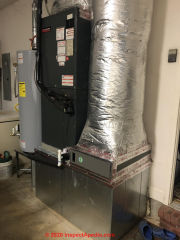 I might start by looking at / for the dust itself to see if it indicates an unusual source that needs to be fixed.
I might start by looking at / for the dust itself to see if it indicates an unusual source that needs to be fixed.
Start by looking for a debris source close to the central air return; continue by looking for leaks that might draw debris into the return air duct system anywhere along its length. Check also that the fine grit is really grit and not insulation from damaged HVAC duct insulation.
On 2020-10-09 by Richard Lanier
The big box Filter shown (Company called it a Merv 11) filter is located above the return Air Plenum which is set on a concrete floor. The arrow air flow points down into the filter... goes into the plenum, then back up into the Air Handler.
We get lots of fine grit like dust in the house unless I add Honeywell FPR 10 Filters to the ceiling return air ducts inside the house. Am a bit frustrated. Is there a good solution for this situation?
On 2020-08-02 - by (mod) -
Olley
Wow what a lot of arm-waving gobbledygook you were fed.
"Knowing about it" isn't the same as understanding the problems of wet crawl space or moldy ductwork.
Unfortunately I can't make your neighbour do anything nor pound sense into him.
"Freon costly" isn't the issue.
If there's a refrigerant leak it'll need to be found and fixed.
We don't "fill up" air conditioners repeatedly with freon - it's not a consumable.
On 2020-07-31 by Olley
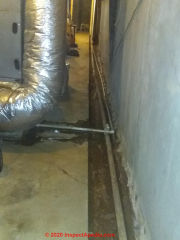 First, I want to say that your website is the best!
First, I want to say that your website is the best!
Here's the problem I'm having. I also have a clueless landlord.......
I live in a "rooming house", an industrial steel+concrete warehouse. The common areas have no A/C. The 6 bedrooms are sharing one HVAC system, and each room has its own thermostat.
The rooms are all side by side, on one side of the house.
The blower unit (the photo I included) is located in a "crawl space" directly behind the middle room. Specifically, it's an uninsulated, damp corridor that runs the length of the building.
On the right side of the photo is a trench whose purpose is to receive drainage from the neighbor's yard, through holes in the bottom of the retaining wall (this side of the building is below ground level).
I went in there yesterday, and I was surprised to see what I thought was a lot of water quickly flowing out the bottom of the unit. Most of it was running towards the trench (at the very end of the trench is a sump pump, and the pipe from it runs along the trench out of the front of the house)).
I took a few photos and a video of the water action. He told me that
1. He says he "knows about it" and that we had the "same problem last summer"
2. He said that the unit was in need of freon that is now "very costly" and also that physically the blower unit is "not level, so the water is spilling out of the pan instead of running out of a tube or pipe"
3. He actually said " I don't know how long we would have to turn the unit off in order to fix the problem" !?!?!?!?!? Really!?!?!??
Additionally, one of the tenants here has his thermostat set to FAN ON + AC OFF. His reason for doing so, is that his room "feels fine that way".
However he also says that his room is "humid" but refuses to tell this to the landlord. He has mold on his wall.(((( Yes, I know.))))
Please help. What do you think is going on here?
On 2020-07-19 - by (mod) - fix bypass leak at air handler filter
Barb: it's not really OK - your air handler is leaking, not filtering all of the air, and it may also be unnecessarily noisy.
There should have been a metal divider that prevents significant air entry if you're using just a 1-inch filter.
You can buy a part that should seal this gap, such as the one shown below, from https://www.supplyhouse.com
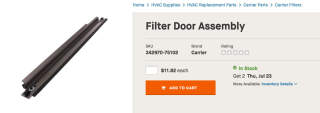
On 2020-07-19 by Barb
I have a Bryant indoor unit it has 2 slots for a filter it’s says put the 1 inch filter on the top slot and remove divider for a 2” filter when I put the 1” filter in the top slot there’s a 2” gap from where the top filter is so air is coming through the opening is this ok
On 2020-07-06 by (mod) - Tech said I had no place for a filter
That's a surprise, as not many installers would put in an HVAC system with no filtration. But if that's the case, Then I would make a place for a filter.
For example you can buy a central return air register inlet grille cover that's hinged and that incorporates space for an air filter.
Running the system with no air filter increases heating and cooling cost and reduces air-flow as house dust clogs the blower fan blades; I've actually measured air flow before and after leaning a dirty blower. The difference was quite significant.
That's illustrated at BLOWER FAN ASSEMBLY CLEANING
On 2020-07-06 by Anonymous
Tech said I had no place for a filter
On 2020-06-28 - by (mod) -
Kathy
In sum, follow the air; find the air return - or returns as depending on your home there could be more than one; Follow the ducts to the air handler.
Look for an air filter right at the return or in the air handler as we describe above.
Perhaps if you post a photo of your air handler I can comment further. (1 photo per comment)
On 2020-06-28 by Kathy
I can not locate the air filter for this 1995 model. I just bought a 1989 manufactured home. Can you help me?
On 2020-06-24 - by (mod) -
Leif
First let's be sure we have not mixed up supply with return air outlets and inlets. With the system running, holding a tissue by any register will give you an indicator or air direction.
The air filter may be at one or more common air returns or at the air handler, or less commonly, in a slot in the return air duct near the air handler.
Please take a look at the suggestions in the article above and let me know what you find.
On 2020-06-24 by Leif
I have a new home and cannot find the filter on the air condition unit in attic, there are no filters in the suction tubes in ceiling
On 2020-06-20 - by (mod) - wire rack or clip holds air filter at top of return air plenum in bottom of air handler
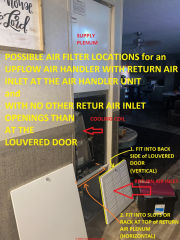 Those photos are helpful Katelyn, below I show some possibilities for air filter location.
Those photos are helpful Katelyn, below I show some possibilities for air filter location.
[Click to enlarge any image]
Tell me the brand and model of your air handler (the brand is on the front and both brand and model will be on a data tag in the air handler perhaps on one side of one of the 3 compartments (air return, cooling coil, air supply plenum at the top).
By the way this unit's location makes it more difficult to service and we already noted rust and suspect a condensate disposal problem.
With brand and model we can find the installation/operation manual for the unit and there see exactly what the manufacturer recommends.
Watch out: operating an air handler for some time without an air filter is likely to clog the blades on the blower fan, substantially reducing air flow from the unit as well as increasing operating cost.
I think that wire rack you showed earlier is intended to hold an air filter into the top of the reutrn air plenum
OR
it may be intended to hold an air filter against the inside face of that grilled return air plenum cover-door at the bottom of the air handler.
I'll illustrate those positions in the photos shown above and below.
Finally here are some notes on your other photo, just for clarification of what you're looking at in the center of your air conditioner or heat pump unit: the cooling coil and its thermostatic expansion valve control and refrigerant piping.
On 2020-06-20 by Katelyn
This is the only thing that has to do with our unit besides the outside unit - I imagine the filter would have to go somewhere in here, just not sure where.
On 2020-06-20 - by (mod) - typical air filter locations at the bottom of an air handler, air conditioner or furnace
That looks to me like the outlet end of an air conditioning system - the supply plenum.
Normally we'd put the air filter on the return side, either at an inlet grille or possibly your earlier photo below is showing a support for an air filter in the return air plenum at what I take to be the bottom of the air handler.
That heavy wire frame may be intended to hold a filter but it'd need a secure mount. Take care: we don't want an air filter to be so poorly supported that it can be sucked into the blower fan - the risk is an overheated motor or even a fire.
Also I don't like seeing that rust in the air handler; find and fix the water source, probably mis-handling of condensate - to reduce the risk of both equipment damage and mold.
Follow the air path, find the return air, that will tell us where a filter can be placed - more illustrations are on the page above.
On 2020-06-20 by Katelyn
There is this rack and in the middle of our air conditioner there is this thing. [Photos below]
On 2020-06-20 - by (mod) - Where would my air filter go?
Katelyn I can't quite make out the situation in your photo - is this the air handler unit cold air return plenum?
Do you see supports that would hold all four side of an air filter.
If not, possibly the air filters on your system are at the return air inlet grille in a ceiling or wall of the building.
On 2020-06-20 by Katelyn
Where would my air filter go? On the side where it’s cut out or on the top where it is black? Also what directions should my arrows be facing?
On 2020-06-02 - by (mod) -
Of course there may be other air filters such as at air returns
On 2020-06-02 - by (mod) - Where is the filters for a ruud achiever super quiet 80
For the Ruud achiever super quiet 80 feater air handler there is a molded permanent air filter that slides down into the back of the unit when you are facing it from the burner side.
On 2020-06-01 by Cynthia
Where is the filters for a ruud achiever super quite 80
On 2019-10-12 - by (mod) - Where is the filter for a Goodman's furnace
Fred
Please help me out with a photo of the Goodman furnace data tag or tell me the furnace model number and serial number and we can see where the manufacturer says the air filter would go. On some systems the filter is behind a service door on the air handler we're on others it may be in the return duct ahead of the air handler.
On 2019-10-12 by Fred
Where is the filter for a Goodman's furnace
On 2019-09-03 - by (mod) - Should my return air inlets have filters in them in addition to the one on the unit?
I like a filter at air inlets as that helps keep the return ducts and blower fan clean;
However if you've already got a proper air filter in or at the air handler that ought to be protecting the blower fan, and I'd be careful about adding more layers of filtration without discussing with your HVAC company the air flow velocity requirements of your system and the restriction of additional filters to be sure you're not slowing the delivery of air through the system.
On 2019-09-03 by Harlan Schlenker
Should my return air inlets have filters in them in addition to the one on the unit? This is a central air and heat.
...
Continue reading at AIR FILTER OPTIMUM INDOOR or select a topic from the closely-related articles below, or see the complete ARTICLE INDEX.
Or see AIR FILTER LOCATION FAQs - questions & answers posted originally at this article
Or see these
Recommended Articles
Suggested citation for this web page
AIR FILTER LOCATION at InspectApedia.com - online encyclopedia of building & environmental inspection, testing, diagnosis, repair, & problem prevention advice.
Or see this
INDEX to RELATED ARTICLES: ARTICLE INDEX to BUILDING INDOOR AIR QUALITY IAQ
Or use the SEARCH BOX found below to Ask a Question or Search InspectApedia
Or see
INDEX to RELATED ARTICLES: ARTICLE INDEX to AIR CLEANERS FILTERS PURIFIERS
Or use the SEARCH BOX found below to Ask a Question or Search InspectApedia
Ask a Question or Search InspectApedia
Try the search box just below, or if you prefer, post a question or comment in the Comments box below and we will respond promptly.
Search the InspectApedia website
Note: appearance of your Comment below may be delayed: if your comment contains an image, photograph, web link, or text that looks to the software as if it might be a web link, your posting will appear after it has been approved by a moderator. Apologies for the delay.
Only one image can be added per comment but you can post as many comments, and therefore images, as you like.
You will not receive a notification when a response to your question has been posted.
Please bookmark this page to make it easy for you to check back for our response.
Our Comment Box is provided by Countable Web Productions countable.ca
Citations & References
In addition to any citations in the article above, a full list is available on request.
- Modern Refrigeration and Air Conditioning, A. D. Althouse, C.H. Turnquist, A. Bracciano, Goodheart-Willcox Co., 1982
- Principles of Refrigeration, R. Warren Marsh, C. Thomas Olivo, Delmar Publishers, 1979
- Complete List of Air Conditioning & Heat Pump Design, Inspection, Repair Books at the InspectAPedia Bookstore.
- In addition to citations & references found in this article, see the research citations given at the end of the related articles found at our suggested
CONTINUE READING or RECOMMENDED ARTICLES.
- Carson, Dunlop & Associates Ltd., 120 Carlton Street Suite 407, Toronto ON M5A 4K2. Tel: (416) 964-9415 1-800-268-7070 Email: info@carsondunlop.com. Alan Carson is a past president of ASHI, the American Society of Home Inspectors.
Thanks to Alan Carson and Bob Dunlop, for permission for InspectAPedia to use text excerpts from The HOME REFERENCE BOOK - the Encyclopedia of Homes and to use illustrations from The ILLUSTRATED HOME .
Carson Dunlop Associates provides extensive home inspection education and report writing material. In gratitude we provide links to tsome Carson Dunlop Associates products and services.


